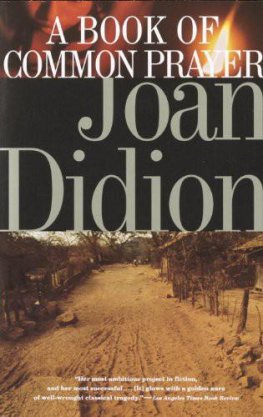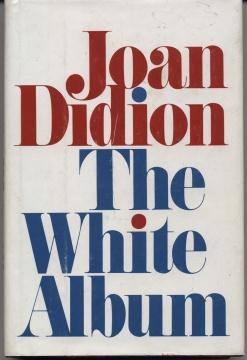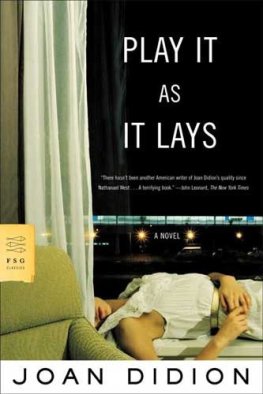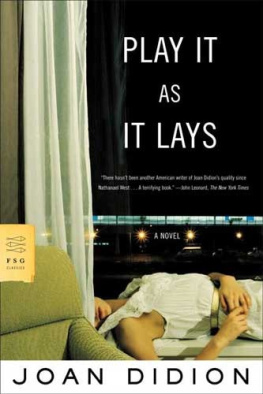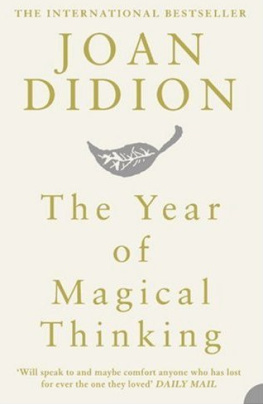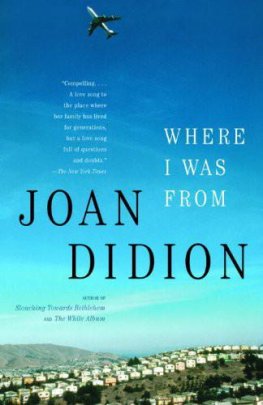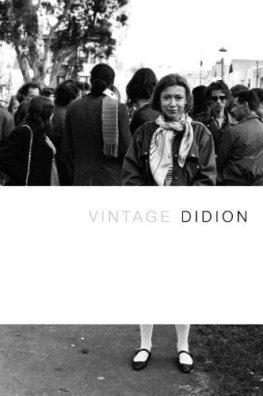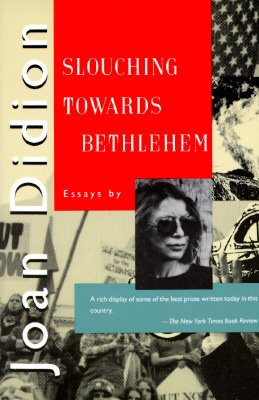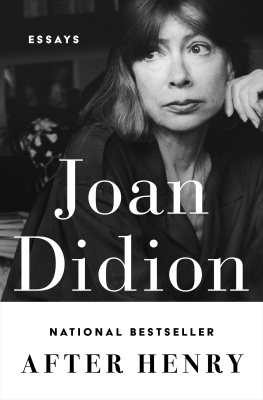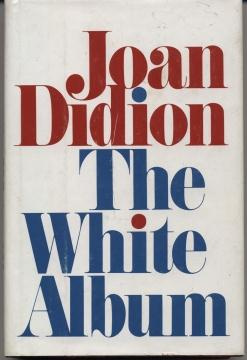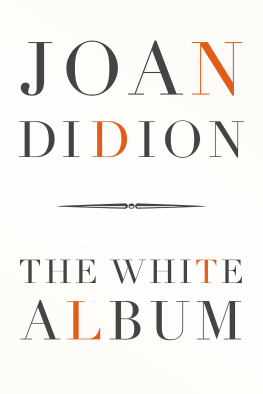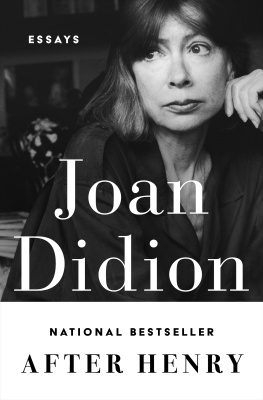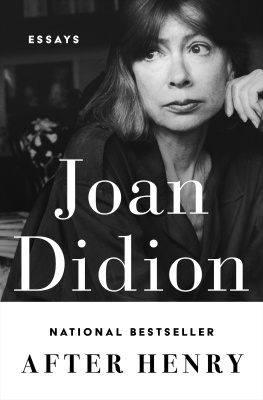Joan Didion
The White Album
1
we tell ourselves stories in order to live. The princess is caged in the consulate. The man with the candy will lead the children into the sea. The naked woman on the ledge outside the window on the sixteenth floor is a victim of accidie, or the naked woman is an exhibitionist, and it would be interesting to know which. We tell ourselves that it makes some difference whether the naked woman is about to commit a mortal sin or is about to register a political protest or is about to be, the Aristophanic view, snatched back to the human condition by the fireman in priests clothing just visible in the window behind her, the one smiling at the tele-photo lens. We look for the sermon in the suicide, for the social or moral lesson in the murder of five. We interpret what we see, select the most workable of the multiple choices. We live entirely, especially if we are writers, by the imposition of a narrative line upon disparate images, by the ideas with which we have learned to freeze the shifting phantasmagoria which is our actual experience.
Or at least we do for a while. I am talking here about a time when I began to doubt the premises of all the stories I had ever told myself, a common condition but one I found troubling. I suppose this period began around 1966 and continued until 1971. During those five years I appeared, on the face of it, a competent enough member of some community or another, a signer of contracts and Air Travel cards, a citizen: I wrote a couple of times a month for one magazine or another, published two books, worked on several motion pictures; participated in the paranoia of the time, in the raising of a small child, and in the entertainment of large numbers of people passing through my house; made gingham curtains for spare bedrooms, remembered to ask agents if any reduction of points would be pari passu with the financing studio, put lentils to soak on Saturday night for lentil soup on Sunday, made quarterly F. I. C. A. payments and renewed my drivers license on time, missing on the written examination only the question about the financial responsibility of California drivers. It was a time of my life when I was frequently named. I was named godmother to children. I was named lecturer and panelist, colloquist and conferee. I was even named, in 1968, a Los Angeles Times Woman of the Year, along with Mrs. Ronald Reagan, the Olympic swimmer Debbie Meyer, and ten other California women who seemed to keep in touch and do good works. I did no good works but I tried to keep in touch. I was responsible. I recognized my name when I saw it. Once in a while I even answered letters addressed to me, not exactly upon receipt but eventually, particularly if the letters had come from strangers. During my absence from the country these past eighteen months, such replies would begin.
This was an adequate enough performance, as improvisations go. The only problem was that my entire education, everything I had ever been told or had told myself, insisted that the production was never meant to be improvised: I was supposed to have a script, and had mislaid it. I was supposed to hear cues, and no longer did. I was meant to know the plot, but all I knew was what I saw: flash pictures in variable sequence, images with no meaning beyond their temporary arrangement, not a movie but a cutting-room experience. In what would probably be the middle of my life I wanted still to believe in the narrative and in the narratives intelligibility, but to know that one could change the sense with every cut was to begin to perceive the experience as rather more electrical than ethical.
During this period I spent what were for me the usual proportions of time in Los Angeles and New York and Sacramento. I spent what seemed to many people I knew an eccentric amount of time in Honolulu, the particular aspect of which lent me the illusion that I could any minute order from room service a revisionist theory of my own history, garnished with a vanda orchid. I watched Robert Kennedys funeral on a verandah at the Royal Hawaiian Hotel in Honolulu, and also the first reports from My Lai. I reread all of George Orwell on the Royal Hawaiian Beach, and I also read, in the papers that came one day late from the mainland, the story of Betty Lansdown Fouquet, a 26-year-old woman with faded blond hair who put her five-year-old daughter out to die on the center divider of Interstate 5 some miles south of the last Bakersfield exit. The child, whose fingers had to be pried loose from the Cyclone fence when she was rescued twelve hours later by the California Highway Patrol, reported that she had run after the car carrying her mother and stepfather and brother and sister for a long time. Certain of these images did not fit into any narrative I knew.
Another flash cut:
In June of this year patient experienced an attack of vertigo, nausea, and a feeling that she was going to pass out. A thorough medical evaluation elicited no positive findings and she was placed on Elavil, Mg 20, tid.The Rorschach record is interpreted as describing a personality in process of deterioration with abundant signs of failing defenses and increasing inability of the ego to mediate the world of reality and to cope with normal stress.Emotionally, patient has alienated herself almost entirely from the world of other human beings. Her fantasy life appears to have been virtually completely preempted by primitive, regressive libidinal preoccupations many of which are distorted and bizarre.In a technical sense basic affective controls appear to be intact but it is equally clear that they are insecurely and tenuously maintained for the present by a variety of defense mechanisms including intellectualization, obsessive-compulsive devices, projection, reaction-formation, and somatization, all of which now seem inadequate to their task of controlling or containing an underlying psychotic process and are therefore in process of failure. The content of patients responses is highly unconventional and frequently bizarre, filled with sexual and anatomical preoccupations, and basic reality contact is obviously and seriously impaired at times. In quality and level of sophistication patients responses are characteristic of those of individuals of high average or superior intelligence but she is now functioning intellectually in impaired fashion at barely average level. Patients thematic productions on the Thematic Apperception Test emphasize her fundamentally pessimistic, fatalistic, and depressive view of the world around her. It is as though she feels deeply that all human effort is foredoomed to failure, a conviction which seems to push her further into a dependent, passive withdrawal. In her view she lives in a world of people moved by strange, conflicted, poorly comprehended, and, above all, devious motivations which commit them inevitably to conflict and failure
The patient to whom this psychiatric report refers is me. The tests mentioned the Rorschach, the Thematic Apperception Test, the Sentence Completion Test and the Minnesota Multiphasic Personality Index were administered privately, in the outpatient psychiatric clinic at St. Johns Hospital in Santa Monica, in the summer of 1968, shortly after I suffered the attack of vertigo and nausea mentioned in the first sentence and shortly before I was named a Los Angeles Times Woman of the Year. By way of comment I offer only that an attack of vertigo and nausea does not now seem to me an inappropriate response to the summer of 1968.
2
In the years I am talking about I was living in a large house in a part of Hollywood that had once been expensive and was now described by one of my acquaintances as a senseless-killing neighborhood. This house on Franklin Avenue was rented, and paint peeled inside and out, and pipes broke and window sashes crumbled and the tennis court had not been rolled since 1933, but the rooms were many and high-ceilinged and, during the five years that I lived there, even the rather sinistral inertia of the neighborhood tended to suggest that I should live in the house indefinitely.


